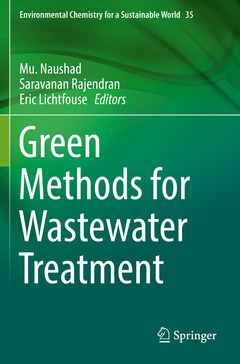Description
Green Methods for Wastewater Treatment, 1st ed. 2020
Environmental Chemistry for a Sustainable World Series, Vol. 35
Language: English
Subjects for Green Methods for Wastewater Treatment:
Publication date: 08-2020
Support: Print on demand
Publication date: 07-2019
292 p. · 15.5x23.5 cm · Hardback
Description
/li>Contents
/li>Biography
/li>Comment
/li>
This book presents comprehensive chapters on the latest research and applications in wastewater treatment using green technologies. Topics include mesoporous materials, TiO2 nanocomposites and magnetic nanoparticles, the role of catalysts, treatment methods such as photo-Fenton, photocatalysis, electrochemistry and adsorption, and anti-bacterial solutions. This book will be useful for chemical engineers, environmental scientists, analytical chemists, materials scientists and researchers.
Chapter 1. Visible-Light-responsive Nanostructured Materials for Photocatalytic Degradation of Persistent Organic Pollutants in Water.- Chapter 2. Surface Modification of Highly Magnetic Nanoparticles for Water Treatment to Remove Radioactive Toxins.- Chapter 3. FeS2 Pyrite Nanostructures: An Efficient Performer in Photocatalysis.- Chapter 4. Green Synthesized Metal Oxide Nanomaterials Photo Catalysis in Combating Bacterial Infection.- Chapter 5. Progression in Fenton Process for the Waste Water Treatment.- Chapter 6. Electrochemical Aspects for Wastewater Treatment.- Chapter 7. TiO2 Based Nanocomposites for Photodegradation of Organic Dyes.- Chapter 8. Light Activated Nanoparticles for Antibacterial Studies.- Chapter 9. Green Technologies for Wastewater Treatment.- Chapter 10. Mesoporous Materials for Degradation of Textile Dyes.
Dr. Mu. Naushad is presently working as an Associate Professor in the Department of Chemistry, College of Science, King Saud University (KSU), Riyadh, Kingdom of Saudi Arabia. He obtained his M.Sc and Ph.D Degree in Analytical chemistry from Aligarh Muslim University, Aligarh, India in 2002 and 2007, respectively. He has a vast research experience in the multidisciplinary fields of Analytical Chemistry, Materials Chemistry and Environmental Science. He holds several US patents, over 250 publications in the international Journals of repute, twenty book chapters and several books published by renowned international publishers. He has >5800 citations with a Google Scholar H-Index of >47. He has successfully run several research projects funded by National plan for Science, Technology and Innovation (NPST) and King Abdulaziz City for Science and Technology (KACST), Kingdom of Saudi Arabia. He is the editor/editorial member of several reputed Journals like Scientific Report (Nature); Process Safety & Environmental Protection (Elsevier); Journal of Water Process Engineering (Elsevier) and International Journal of Environmental Research & Public Health (MDPI). He is also the associate editor for Environmental Chemistry Letters (Springer) and Desalination & Water Treatment (Taylor & Francis). He has been awarded the Scientist of the year award-2015 from National Environmental Science Academy, Delhi, India and Almarai Award-2017, Saudi Arabia.
Dr. Saravanan Rajendran hasreceived his Ph.D in Physics-Material Science in 2013 from the Department of Nuclear Physics, University of Madras, Chennai, India. He was awarded the University Research Fellowship (URF) during the year 2009-2011 by the University of Madras. After working as an Assistant Professor in Dhanalakshmi College of Engineering, Chennai, India during the year of 2013-2014, he was awarded SERC and CONICYT-FONDECYT post-doctoral fellowship, University of Chile, Santiago




